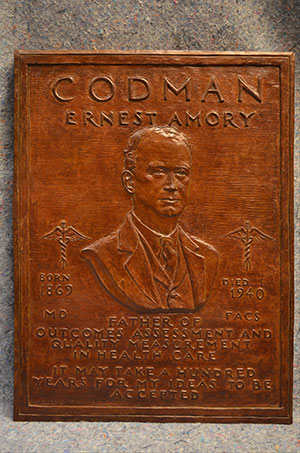News – Nearly 74 Years After His Death, a Headstone Memorializes Ernest Amory Codman Boston surgeon is remembered for his visionary work in promoting medical outcomes.
 To recognize the contributions of Ernest Amory Codman, MD, FACS (1869-1940), to American surgery and to patient care as a whole, a memorial headstone has been placed at his previously unmarked gravesite in the historic Mount Auburn Cemetery in Cambridge, Massachusetts. Leaders from the American College of Surgeons (ACS) and other medical organizations gathered at a dedication event on July 22, 2014, at Mount Auburn to view the Codman Memorial stone and to pay homage to the renegade surgeon from Boston, well known for advocating the “End Result Idea” in medicine.
To recognize the contributions of Ernest Amory Codman, MD, FACS (1869-1940), to American surgery and to patient care as a whole, a memorial headstone has been placed at his previously unmarked gravesite in the historic Mount Auburn Cemetery in Cambridge, Massachusetts. Leaders from the American College of Surgeons (ACS) and other medical organizations gathered at a dedication event on July 22, 2014, at Mount Auburn to view the Codman Memorial stone and to pay homage to the renegade surgeon from Boston, well known for advocating the “End Result Idea” in medicine.
The “Idea” simply was the common-sense premise that hospital staffs would follow every patient they treated long enough to determine whether or not the treatment was successful, then learn from any failures, with a goal of preventing similar failures in the future (Roberts et al., 1987).
Dr. Codman was a maverick whose ideas were not entirely appreciated by his peers during his lifetime, but whose ideas have become the basis of patient-centered, quality-based surgery promoted in ACS standards and in current-day medical practice. Throughout his storied career, his viewpoint, and his passion for promoting it, typically placed him at bitter odds with the medical establishment to the point that it became difficult for him to earn a living. When he died of melanoma in 1940, his family reportedly did not have the financial means to purchase a headstone for his gravesite so he was interred in an unmarked site in his wife’s family lot at Mount Auburn Cemetery (Mallon, 1999).
“The American College of Surgeons, and medicine in general, owe a huge debt of gratitude to Dr. Codman, who was one of our organization’s early leaders,” said ACS Executive Director David B. Hoyt, MD, FACS. “He contributed immensely to our early hospital standardization activities that eventually led to the establishment of the Joint Commission on Accreditation of Healthcare Organizations (now The Joint Commission) in 1951. And decades later, I think he would be proud to see how his advocacy for tracking patients’ outcomes contributed to the development of robust surgical data registries—one of the most valuable tools surgeons use to improve the quality of patient care today.
The headstone was created using historic Quincy Granite that can be found at many gravesites at Mount Auburn. The Memorial was crafted by classical sculptor Daniel Altshuler, DIA Sculpture Studios Ltd., Boston.
During the memorial event, ACS leaders expressed their deep gratitude to all donors for their assistance in securing the memorial headstone for Dr. Codman, an icon in American surgery, whose ideas have contributed to the framework for surgical quality improvement in the United States. For a list of donors visit www.facs.org/news/2014/codmanmemorialdonors.html.
REFERENCES
Mallon, B. (1999). Ernest Amory Codman: The end result of a life in medicine. Philadelphia: W.B. Saunders.
Roberts, J. S., Coale, J. G., & Redman, R. R. (1987). A history of the joint commission on accreditation of hospitals. JAMA, 258(7), 936–940.
